Symptoms and Treatment of Vulvodynia
Many women suffer from a condition called vulvodynia. This condition is specific to women and can cause pain, itching and extreme discomfort in the genital region. There is no known cause of this irritation of the outer genital area and it can start suddenly, lasting for months or years. Many women find this condition makes it difficult or impossible to enjoy sex and many other activities; it can be painful to even sit for long periods of time.
Symptoms of vulvodynia include a burning, itching, throbbing or stinging sensation in the genital region. This can be constant or at irregular intervals. Different women have various levels of pain and discomfort; there is no known cause or cure, but there are options to treat the symptoms of this condition.
Treatment, like the symptoms, can vary. It may take one or more different treatments to find the right combination to relieve symptoms. Some options include medications such as steroids, antihistamines and tricyclic antidepressants. Local anesthetics have also been used for relieving temporary discomfort. Non-invasive treatments include biofeedback or pelvic floor therapy to work with the body’s own defenses. For severe cases, surgery or nerve blocks may be used to offer relief.
Those with vulvodynia can have a lowered quality of life due to the pain and discomfort. It can make intimate sexual relations painful, as well as many sport activities. While it can be embarrassing for some women to discuss, treatment can alleviate many of the symptoms. If you have been suffering from any symptoms of vulvodynia or been diagnosed with the condition, consult a dermatologist who specializes in treating this condition. You can find relief and improve your quality of life.
Posted on behalf of:
Olansky Dermatology Associates
Peachtree Lenox Building
3379 Peachtree Road #500
Atlanta, GA 30326
(404) 355-5484
The information provided on this website, including text, graphics, images, and other materials, is intended solely for informational purposes and should not be used as a substitute for professional medical advice, diagnosis, or treatment.

)